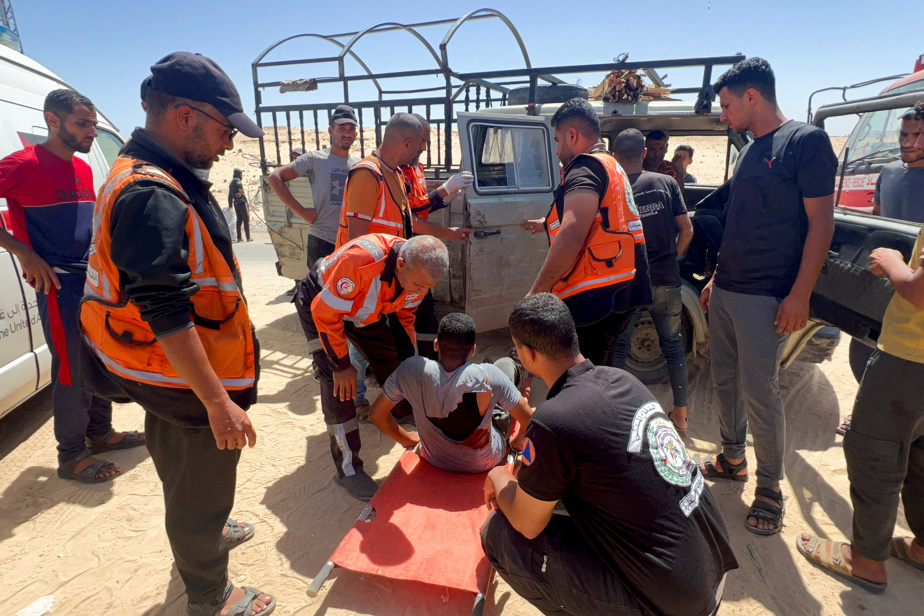(Rafah) Israeli air force and artillery intensively bombarded the city of Rafah on Saturday, hours after US President Joe Biden announced Israel’s road map for a ceasefire with Palestinian Hamas in the Gaza Strip.
Since Mr. Biden’s statement on Friday evening, Israeli Prime Minister Benjamin Netanyahu has twice repeated the “conditions” for a permanent ceasefire: the “destruction” of Hamas, the “release of all hostages” kidnapped during Hamas’ October 7 attack on Israel, and “the assurance that Gaza will no longer pose a threat” to the Israeli state.

PHOTO EVELYN HOCKSTEIN, REUTERS
President Joe Biden
Even though he said he considered the road map announced by Mr. Biden “positively,” Hamas, in power in Gaza since 2007, continues to demand a permanent ceasefire and a total withdrawal of Israeli forces from the territory. Palestinian before any agreement.
While the American announcement has aroused reactions of hope around the world, the belligerents still seem inflexible, on 8e month of the war triggered by an unprecedented attack by Hamas against Israel on October 7, which resulted in the death of 1,189 people, the majority civilians according to an AFP count based on official Israeli figures.
In response, Israel promised to destroy this movement, which it considers terrorist, along with the United States and the European Union. Its army besieged the small, crowded Palestinian territory and launched a massive offensive that has killed 36,379 people so far, according to data from the Health Ministry of the Hamas-led Gaza government.
In the last 24 hours, at least 95 Palestinians have died across the territory, the same source said on Saturday.
“The bombings have not stopped”
Israeli forces, who advanced this week to the center of Rafah, continued their offensive in this town in the south of the Gaza Strip and bordering Egypt, despite protests from the international community which is concerned about the civilians.
Operations are particularly concentrated in the west of the city, in the Tal al-Sultan district, where residents have reported air raids, tank fire and movements of military vehicles.
“All night long, aerial and artillery bombardments did not stop for a moment in western Rafah,” a resident told AFP. “Israeli shooters took up positions on buildings overlooking Tal al-Sultan.”
Intense artillery fire was also reported by witnesses in eastern and central Rafah, where the army launched its offensive on May 7 in order, it said, to destroy the last Hamas battalions.
The army said it was carrying out “targeted operations” in Rafah, which had become the epicenter of the war. His soldiers “located numerous weapons and openings of underground tunnels there”.
“Jabalia wiped off the map”

PHOTO OMAR AL-QATTAA, AGENCE FRANCE-PRESSE
Rescuers search the rubble of a building in Jabalia.
Since the start of the Rafah offensive, a million people have fled to the crowded coastal area of al-Mawasi, further west. Life has become “apocalyptic” in certain areas of the southern Gaza Strip, the UN has warned.
It warns of a risk of famine in the Palestinian territory, where the majority of the approximately 2.4 million inhabitants have been displaced, and affirms that there is no longer a safe place in Gaza.
Adding to the humanitarian catastrophe, the Rafah crossing with Egypt, crucial for the entry of international aid, has been closed since Israeli forces took control of it from the Palestinian side on May 7.
A meeting dedicated to this passage is planned for Sunday in Egypt with the United States and Israel, according to Egyptian media.
Elsewhere in the Palestinian territory, the Palestinian camp of Nousseirat (center) was hit by airstrikes and the neighborhood of Zeitoun in Gaza City (north) was the target of fire, according to witnesses.
Still in the north, residents returning to the Jabalia camp after the end of a new Israeli ground operation say they are shocked by the scale of the destruction.
“Jabalia has been wiped off the map,” denounces Souad Abou Salah, originally from the camp. “It’s as if an earthquake had hit the camp,” exclaims Mohammad al-Najjar.
” It’s time ”
By announcing the road map proposed by Israel and which aims to achieve, in stages and under conditions, a permanent ceasefire, Mr. Biden called on Hamas to accept it.
The first phase, he said, would be a ceasefire with an Israeli withdrawal from densely populated areas of Gaza for six weeks. The end of the fighting would be accompanied in particular by the release of certain hostages held in Gaza, especially women and the sick, and the release of Palestinians detained by Israel.
Of the 252 people kidnapped on October 7, 121 are still held in Gaza, of whom 37 are dead, according to the Israeli army.
The contours of phase two of the plan, according to Joe Biden, will be negotiated during the six-week ceasefire. Hostilities will not resume as long as discussions continue.
In the event of successful negotiations, the fighting stops definitively and all the hostages still held in Gaza return home, including soldiers. And Israeli forces are completely withdrawing from the territory.
“It’s time for this war to end,” Mr. Biden said. “We cannot pass up” this opportunity.
